- हिन्दी ( Hindi )
- اردو ( Urdu )
- U.S.-India Relations

The Nehru Visit
Few foreign visitors to the United States have attracted greater public attention than Prime Minister Nehru who paid his fourth visit to that country in November 1961, accompanied by his daughter, Mrs. Indira Gandhi.
Retrospective Edition, January 2022
Gathered around Prime Minister Nehru at International Airport in Washington, as he responds to President Kennedy’s welcome, are, left to right, U.S. Ambassador to India J.K. Galbraith, Secretary of State Dean Rusk, Indian Ambassador to the United States B.K. Nehru, Vice President Lyndon Johnson and President Kennedy.
Few foreign visitors to the United States have attracted greater public attention than Prime Minister Nehru who paid his fourth visit to that country in November, accompanied by his daughter, Mrs. Indira Gandhi.
Apart from the thousands of Americans who greeted the distinguished statesman at the various public functions organized in his honor, millions saw his thoughtful face reflected from their television sets and heard his sincere and pleasant voice on both television and radio. During the 10 days he was in the country, Prime Minister Nehru’s photograph was the one the reader was most likely to come across in the 1,800 daily newspapers and the thousands of magazines and periodicals published in the United States.
The exchange of views on world topics between the Prime Minister and President Kennedy was, in the words of the joint communique, “highly useful in the pursuit of their common objectives of an enduring world peace and enhanced understanding between the Governments of India and the United States.” The meetings afforded a unique opportunity for the two world leaders to examine thoroughly their respective positions on vital problems of peace, nuclear tests and disarmament, and resulted in greater mutual confidence and respect. The President was voicing the general regard in which Americans hold Mr. Nehru when he said, “Your reputation has spread beyond your borders and has been an inspiration for people throughout the world.”
As guest of the National Press Club in Washington, Mr. Nehru met some 500 working journalists and answered their questions with much frankness and good humor. In New York he addressed the United Nations General Assembly and suggested the observance of a “world cooperation year.” He pointed out that while “little is said about the vast amount of international cooperation that exists, much is said about conflict.”
Mr. Nehru’s 72nd birth anniversary coincided with his visit to the United States, and it was fitting that, as part of the birthday celebrations, “Uncle Nehru” should have been greeted by an international group of children at Disneyland, the fabulous amusement park near Los Angeles designed by Walt Disney. One of his last engagements was at Los Angeles where he had planned to meet some 500 Indian university students at a birthday gathering. Instead, 3,500 enthusiastic American students also turned up to wish the Prime Minister a happy birthday and give him a warm send-off.
Originally published in January 1962
- U.S.-India relations
Leave a Reply Cancel reply
Your email address will not be published. Required fields are marked *
LATEST ARTICLES
On a mission of empowerment, championing inclusivity.
- Advocating for a Queer-Friendly World
- Queer and Proud
- Transforming a Community’s Future
Shooting for the Stars
- Smart Water Solutions
- RELATED ARTICLES
- MORE FROM AUTHOR
Enhancing Quad Knowledge
Helping women fulfill aspirations, leading the way, सशक्तिकरण के मिशन पर, بااختیار بنانے کا مشن.
Disclaimer: This site is produced and maintained by the U.S. Embassy New Delhi. Links to other Internet sites should not be construed as endorsement of the views contained therein. The opinions expressed in the content do not necessarily reflect the views or policies of the U.S. Government.
Foreign Relations: The Nehru Visit
B y Kennedy standards of hospitality, the program planned for Jawaharlal Nehru’s official U.S. visit this week is as austere as vegetable curry. Wryly mindful of the pomp and circumstance unlimbered for his old foe, Pakistan’s Ayub Khan, India’s Prime Minister expressly requested Washington to forgo “medieval splendor.” From a private luncheon with President Kennedy at Newport to an address before the U.N. General Assembly, from Broadway’s Camelot to California’s Disneyland, Nehru’s crowded schedule barely left him time to change the perennial red rose on his achkan tunic.
Nehru, who last visited Washington in 1956, complained only a few years ago that he was “flat and stale.” But Nehru who will be 72 next week, has lately radiated energy and good health. His ivory-tower idealism has also been pierced by a new sense of realism in world affairs. Russia’s violence and Red China’s aggressions have left him no illusions about Communism’s world ambitions. Thanks largely to able U.S. ambassadors, including Kennedy-appointed John Kenneth (Affluent Society) Galbraith, Nehru has gained new understanding of U.S. aims. Says he: “As far as we are concerned, there are no problems between India and the U.S.”
Turning the Corner. Never has U.S. prestige stood higher in Nehru’s country. With massive Western aid, nearly $4 billion of it in U.S. loans and gifts, India since 1951 has gone far along the road to becoming a stable, economically viable democracy. Its faith in continued U.S. assistance has been confirmed by commitments of $1 billion for the first two years of India’s third five-year plan; with its completion in 1966, Indians hope they will have turned the corner, in Nehru’s words, “from an underdeveloped to a self-developing nation.”
India is still capable of some strangely irrational attitudes, notably in the U.N., where Nehru’s delegates still urge an immediate, uninspected, unenforceable nuclear test ban. Defense Minister V. K. Krishna Menon argues that Khrushchev was forced into the new Russian bomb tests by the U.S., an attitude that U.S. Delegate Arthur H. Dean acidly describes as pro-Soviet neutralism. In view of Menon’s rantings, the U.S. particularly wants to explain to Nehru the military realities in Laos and South Viet Nam.
While loyal to Menon—who is not accompanying him on the trip—Nehru is plainly troubled by U.S. criticism. He even had a lavish—for Nehru—compliment for his hosts: “The U.S. has done much to advance human civilization. It has something much more than materialism. It has spiritualism and idealism and many things in common with India.”
More Must-Reads from TIME
- Welcome to the Noah Lyles Olympics
- Melinda French Gates Is Going It Alone
- How to Buy Groceries Without Breaking the Bank
- What’s the Best Pillow Setup for Sleep?
- How Improv Comedy Can Help Resolve Conflicts
- 4 Signs Your Body Needs a Break
- The 15 Best Movies to Watch on a Plane
- Want Weekly Recs on What to Watch, Read, and More? Sign Up for Worth Your Time
Contact us at [email protected]
- Skip to Main Content
- Screen Reader Access

- Vision & Mission
- Family Tree
- Swaraj Bhawan
- Anand Bhawan
- Teen Murti House
- Freedom Struggle
- Prime Minister
- Nehru Papers
- Papers of Nehru’s Contemporaries
- Oral History
Search form
Nehru's visit to u.s., 1961(part-i).
Nehru's Visit to U.S., 1961(Part-I)
Please Enable Js to View all Pages.
- India Today
- Business Today
- Harper's Bazaar
- Brides Today
- Cosmopolitan
- India Today Hindi
- Reader’s Digest
- Aaj Tak Campus
America's discovery of Nehru: From 'difficult to deal with' to 'essential to India'
As prime minister narendra modi is in the us on a state visit, we take a look at the us trips of jawaharlal nehru, independent india's first pm. despite being given personal attention, why the americans found nehru "very difficult to deal with" and how india, battling grain shortage, was even denied any food aid. here's the history of it..
Listen to Story
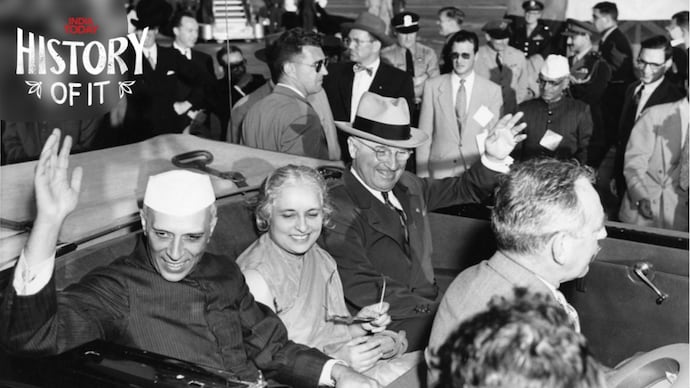
Prime Minister Narendra Modi is in the US on his first State visit, something that has excited the world media and Indians everywhere. He is only the third Indian leader to be accorded a State visit by the US, the other two being his predecessor Manmohan Singh and former President Sarvepalli Radhakrishnan.
The world saw how PM Modi was accorded a warm welcome by US President Joe Biden and First Lady Jill Biden. The White House lawns also have been flooded by people of Indian origin. Trailblazing deals have been inked . And both Joe Biden and PM Modi have spoken in one voice on key issues and critical questions.
PM Modi is the 14th prime minister of India. How was the first US visit for Jawaharlal Nehru, Independent India's first prime minister? And how did the equations change during his subsequent visits?
NEHRU'S FIRST VISIT TO THE US
Jawaharlal Nehru was apprehensive about visiting the US, and a lot of the apprehension stemmed from his socialist ideology.
On October 11, 1949, Jawaharlal Nehru arrived in Washington on his first visit - at the age of 60. Before his visit, Nehru, who fondly joked that "one should never go to America for the first time", wrote to his sister Vijayalakshmi Pandit, who was then India's Ambassador to the US.
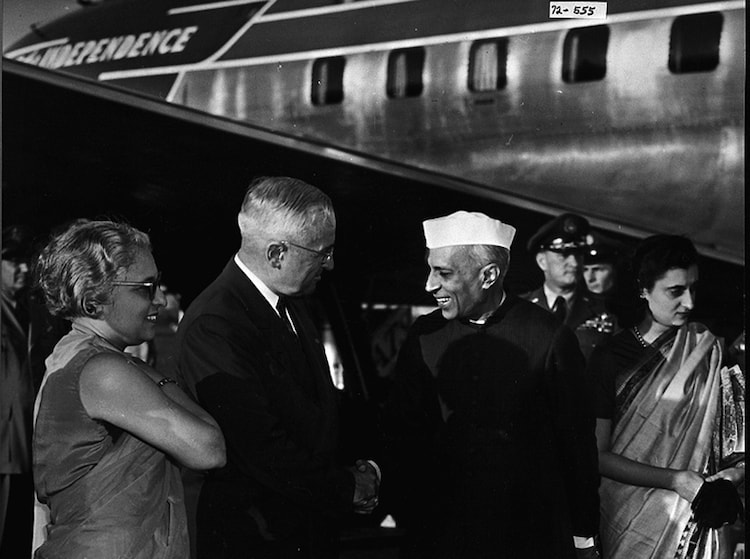
Nehru, in response, called it a moment of "great significance" for him and one that brought about "fulfilment of a long-felt desire".
However, the Americans were left disappointed as Nehru stuck to his non-alignment policy amid the Cold War.
Also Read | 'If I had a conversation with PM Modi...': Obama, hours before Modi-Biden statement
But what did Nehru achieve from his visit?
Nehru, being the leader of a young nation, inherited a large share of problems left behind by British colonial rulers. The Bengal famine of 1943 had left India's granaries starving and Nehru wanted the US to provide food aid to India.
However, according to an account of the US Office of the House Historian, Truman declined to offer US economic aid to India, mainly because of India's neutral stand in the Cold War between the US and the Soviet Union.
Two years later, the US did sign a loan deal with India, allowing New Delhi to purchase two million tonnes of wheat.
In his book 'From Midnight to Glorious Morning?: India Since Independence', British-Indian journalist Mihir Bose described Nehru's 1949 US visit as a "huge political failure". Nehru did manage to wow some Americans, but his lofty air could not convert that into policy success.
RAPPORT WITH EISENHOWER -- AND JACKIE
Jawaharlal Nehru made three more visits to the US as prime minister -- in 1956, 1960 and 1961. Two of these were official visits.
The one in 1960 was primarily for attending the UN General Assembly session, but Nehru met US Dwight D Eisenhower.
The 1956 visit was the moment when Nehru partially warmed up the US.

Video | India-US partnership has entered a new level, says PM Modi in joint address with President Biden
In 1961, Nehru again went to the US on an official visit.
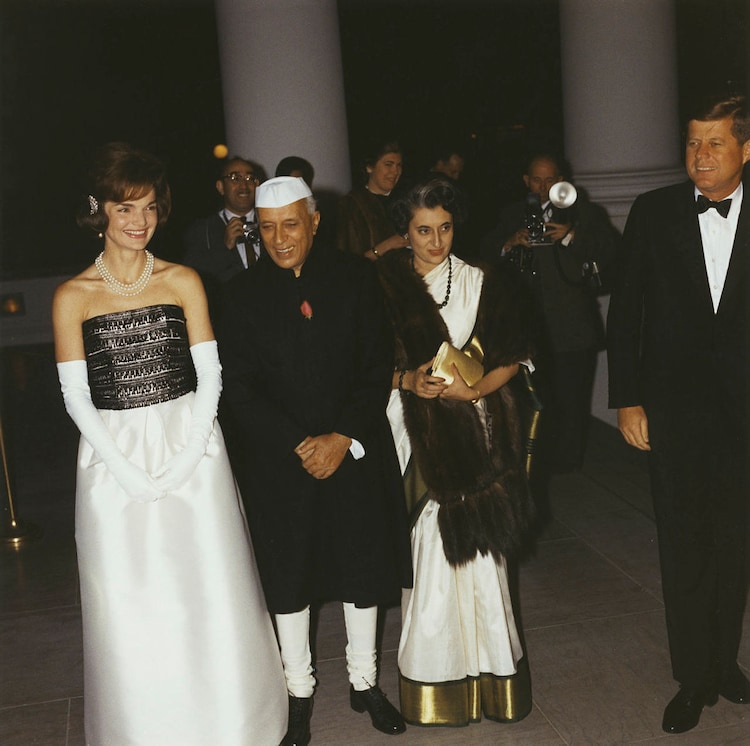
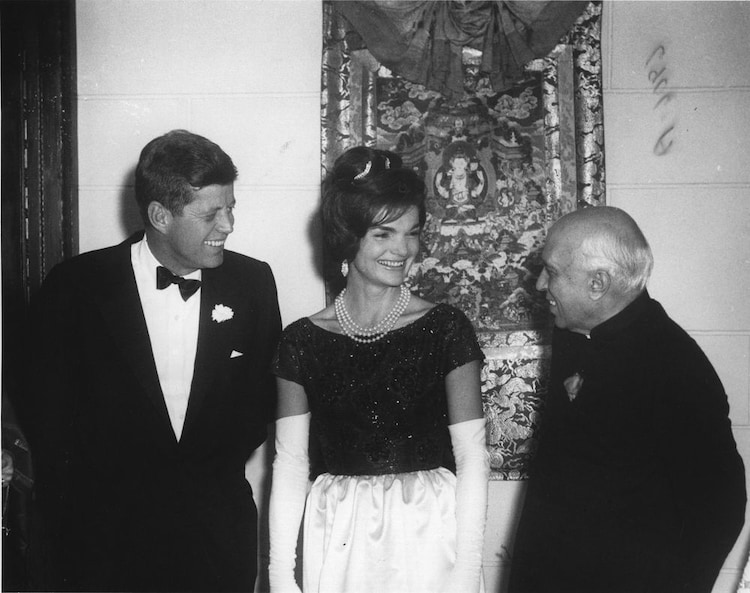

- >>
Nehru in the USA
Video clips of three visits.

NEW DELHI: At the Howdy Modi event at Houston it was left to the United States House Majority leader Steny Hoyer to quote the “father of India’s independence” Gandhi on democracy: “‘Something that gives the weak the same chance as the strong’ - that my friends is what the ideal of the American democracy and the Indian one are all about. Equal opportunity to dream and make the dreams come true.”
And to recall the India that gained independence to secure “a future according to Gandhi’s teachings and Nehru’s vision. As a secular democracy with respect for secularism and human rights, to safeguard every individual.” Hoyer addressing the Indian-Americans, with Prime Minister Narendra Modi standing beside him spoke of how on the eve of India’s independence Nehru had praised and quoted Gandhi, and together both had pledged that “so long there are tears and suffering so long our work will not be over.” The Majority leader went on to quote the late US President Abraham Lincoln who had called for “malice towards none and charity for all.” This speech widely circulated on the social media brought India’s first Prime Minister Jawaharlal Nehru back into the public eye on the ever active social media, with Congress leader Shashi Tharoor tweeting a photograph that he claimed was of Nehru’s visit to the USA, except that it was of Moscow.
However, Nehru did make three important visits to the US in 1949, 1956 and 1961. The video clips below of these visits speak of the warm welcome he received in those times from the successive Presidents of the US, Harry S. Truman, Dwight D.Eisenhower and John F.Kennedy with whom he had three meetings during the one visit. 1949
Latest News


THE CITIZEN BUREAU
Similar posts.

- Skip to global NPS navigation
- Skip to the main content
- Skip to the footer section

Exiting nps.gov
Prime minister jawaharlal nehru.

Eisenhower NHS Photo
Jawaharlal Nehru was born on November 14, 1889, in Allahabad, India. He was leader of India’s nationalist movement and India’s first prime minister after independence (1947-1964).
Nehru was educated at home until age 16 and then continued his education in England at the Harrow School and later at Trinity College in Cambridge, where he earned a degree in natural science. He then studied law at the Inner Temple in London before returning to India in 1912 where he practiced law until 1919.
In 1919, Nehru became aware of the Jallianwala Bagh massacre. The massacre, also known as the Massacre of Amritsar, was an event in which 379 innocent people were killed and at least 1,200 wounded when the British army continuously fired for ten minutes on a crowd of unarmed Indians. The incident changed Nehru's life. In concert with his father, Motilal Nehru, Jawaharlal devoted himself to the struggle for India’s independence from the British Empire.
During the Non-Cooperation Movement (1920-22) led by Mahatma Gandhi, Nehru was imprisoned for the first time for activities against the British government. Over the next two and a half decades, he spent a total of nine years in jail. Given his compelling oratory and close association to Gandhi, he was elected president of the Indian National Congress in 1929. From 1930 to 1936, Nehru was in jail for conducting civil disobedience campaigns.
During World War II, Nehru desired to support the Allied war effort. However, Nehru’s views on the war differed from those of Gandhi. Initially, Gandhi believed that whatever support was given to the British should be given unconditionally and that it should be of a nonviolent character. Nehru held that nonviolence had no place in defense against aggression and that India should support Great Britain in a war against Nazism but only as a free country.
Nehru was imprisoned nine times during WWII over involvement in actions related to support for Indian independence from Great Britain. He was released from his last detention on June 15, 1945.
In 1946, Nehru joined India’s interim government as deputy prime minister (the British viceroy being considered prime minister) and minister of external affairs. From India’s independence in 1947 until his death, Nehru continuously held the posts of prime minister and minister of external affairs. In 1947, despite his reservations, Nehru acquiesced to the Muslim League’s plan to divide India, and in August 1947, Pakistan was created - Pakistan being primarily Muslim and India predominantly Hindu.
Nehru’s name is associated with the development and implementation of the basic principles of the internal and foreign policy of the Republic of India, which have been referred to as the “Nehru course.” Chiefly, he oversaw India's transition from a colony to a republic, while nurturing a plural, multi-party system.
Starting in the late 1940s, both the United States and the U.S.S.R. began seeking out India as an ally in the Cold War. However, Nehru, led a “non-alignment policy”, by which India and other nations wouldn’t feel the need to tie themselves to either country in order to thrive. Therefore, Nehru is considered a founder of the Non-Aligned Movement (NAM) of nations professing neutrality.
Prime Minister Nehru visited the United States in late 1956, arriving in Washington D.C. on December 16. On the following morning, President Eisenhower met him at the Blair House and together they drove to Eisenhower’s Gettysburg farm. Nehru’s visit to the farm was the first of a foreign leader and was carefully fitted into the official itinerary. Together they spent that day and part of the next in some fourteen hours of conversation. During the visit, Nehru became the only world leader to stay overnight at the farm as part of his visit during the Eisenhower administration.
On December 18th, Nehru and Eisenhower returned to Washington. Nehru went to the White House the next morning and they continued private talks. In the end, President Eisenhower had made fourteen pages of notes on their conversations.
Some of the topics discussed during the visit addressed India’s neutrality, socialism, and the way the “third world” viewed the actions of the President of the United States. More specifically, what was the Indian government’s stance on the U.S. actions during the Hungarian Revolt and the Suez Crisis? Prime Minister Nehru was an information conduit for President Eisenhower on how "third world" nations viewed the West.
In his memoir Waging Peace 1956-1961 , President Eisenhower stated that he liked Prime Minister Nehru and that he deeply sympathized with the problems that Chinese aggression had caused India. He believed that Nehru sincerely wanted to help the Indian people and lead them to higher levels of living and opportunity. He thought it fair to conclude that Nehru was essential to India.
Dwight D. Eisenhower Memorial , Eisenhower National Historic Site
You Might Also Like
- dwight d. eisenhower memorial
- eisenhower national historic site
- president eisenhower
Last updated: July 22, 2022
Find Brut. on:
Indian edition
PM Nehru’s 1961 trip to the US
He was invited for dinner at the White House, spoke at the UN General Assembly, and interacted with the diaspora… This was Prime Minister Nehru in 1961.
- Share on WhatsApp
- Share on Facebook
- Share on Twitter
- Copy the URL
You will like also
- Ground Reports
- 50-Word Edit
- National Interest
- Campus Voice
- Security Code
- Off The Cuff
- Democracy Wall
- Around Town
- PastForward
- In Pictures
- Last Laughs
- ThePrint Essential

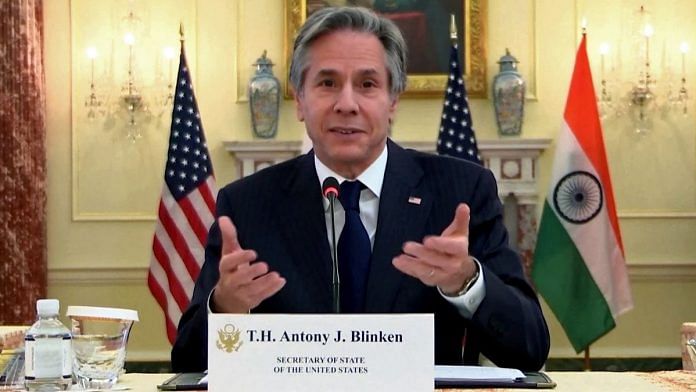
New Delhi: During the 2+2 ministerial dialogue attended by Indian and American foreign and defence ministers in Washington Monday, US Secretary of State Antony J. Blinken made a reference to the first-ever summit level meeting held between an Indian and American head of state.
On 11 October 1949, former Indian Prime Minister Jawaharlal Nehru arrived in Washington where he was warmly welcomed by former US President Harry S Truman. Nehru spent three weeks travelling across the US, meeting members of the House and Senate and addressing several meetings in which he laid out India’s foreign policy interests. According to Blinken, the visit marked the start of a “friendly and fruitful cooperation” between the two countries.
“Very soon after our countries established diplomatic relations, some 75 years ago, Prime Minister Nehru came to visit the United States. President Truman met him on the tarmac of the airport. And Prime Minister Nehru noted the importance of the moment, saying, and I quote: ‘I trust that these two republics of the Western World and the Eastern World will find many ways of working together in friendly and fruitful cooperation to our mutual advantage, and for the good of humanity’,” said Blinken Monday.
“So for nearly 75 years, we’ve done just that. And I’m grateful to our partners for making it possible for that ‘friendly and fruitful cooperation’ to continue and to deepen,” he added.
Blinken’s comments come at a time when differences have arisen between New Delhi and Washington amid the Ukraine war, whether over India’s oil trade with Russia or its decision to abstain from votes criticising Russia at the United Nations. Earlier this month, US Deputy National Security Advisor for International Economics, Daleep Singh, had also warned New Delhi against continuing energy trade with Russia.
Nehru and Truman’s visit in 1949 also came amid frictions vis-à-vis changes in the international order. The Chinese Communist Party had just come into power and the Cold War had just started.
ThePrint explains the historic 1949 visit, the bonhomie between the two leaders and whether Nehru achieved what he sought to achieve from the visit.
Also read: Bid to save funds or a catastrophe? Why govt has merged 4 film bodies under I&B ministry
‘Good-will tour’
As noted by most historians and media reports at the time, Nehru was given a warm welcome upon his maiden visit in Washington DC in 1949, flying in on Truman’s personal plane The Independence. This was the first of Nehru’s four visits to the US — returning in 1956, in 1960 and in 1961.
While on the tarmac at the Washington National Airport on 11 October 1949, both leaders made brief remarks. Truman referenced explorer Christopher Columbus by saying , “Destiny willed it that our country should have been discovered in the search for a new route to yours. I hope your visit, too, will be in a sense a discovery of the United States of America.”
Nehru, as noted by Blinken at Monday’s meeting, expressed hope that the two countries would embark on “friendly and fruitful cooperation” that would work to both their advantages, whilst also serving the “good of humanity”.
Popularly described as a “ goodwill tour ”, Nehru spent three weeks touring the US. He met members of the House and the Senate and also made trips to metropolises such as Chicago and New York as well as places like Tennessee Valley and Illinois in the countryside. He interacted with businesspersons, artisans and academics alike.
The former Indian prime minister was accompanied by the first secretary general in the Ministry of External Affairs, G. S. Bajpai, as well as Nehur’s daughter, Indira Gandhi, who later became the country’s prime minister too.
Bonhomie between Nehru and Truman
Given the warm hospitality at Washington and Truman’s intent to help Nehru ‘discover’ his country, the two leaders developed a bonhomie during the 1949 visit. According to an archived report by The Hindu , Truman had remarked, “Pandit Nehru has made a profound impression on me…He is not only a fine gentleman but a great public servant”.
He hoped the visit would lead to more cordial relations between India and the US, the report added.
Before leaving, Nehru penned a letter dated 6 November, 1949, to the former American president.
“My dear Mr President, I am leaving the United States tomorrow on my way back home. On the eve of my departure, I must again convey to you my deep gratitude for your great kindness and hospitality. I have spent three and a half weeks in this great and wonderful country and have been greatly impressed by what I have seen and heard. Above all I have been moved by the generous and warm-hearted welcome that I have received everywhere from all classes of people and the goodwill that has been shown not only to me but to my country also,” read the letter.
“I am sure that my people have also been moved, as I have been, and that this visit of mine has led to a deeper understanding between our respective countries leading to closer bonds in future,” it added.
Truman’s subsequent correspondence reveals that Nehru had also gifted him a portrait.
“My dear Mr. Prime Minister, I have received with appreciation your gracious letter and your portrait sent upon your departure from the United States. You may be assured that your visit has been a source of great pleasure not only to me, but to the American people,” Truman wrote in a letter dated 23 November, 1949.
Also read: Built with Israeli know-how & an Indian touch, new MRSAM system is key addition to Army arsenal
Did the visit achieve what it needed to?
Experts have noted that apart from starting a new chapter in bilateral relations, Nehru sought to secure commitments of food aid during his visit to the US in 1949, given the Bengal famine had occurred just six years earlier.
In this respect, some reports called the visit a “flop”. A Politico report noted, “Nehru’s session with Truman proved to be a flop; the president declined to offer US economic aid to a nation that recently emerged from British colonial rule and had proclaimed itself neutral in the developing Cold War with the Soviet Union.”
However, some experts felt the visit was important as it included an eye-opening meeting with farmers in Illinois’ Fox River Valley.
A 2018 blog post published in the Truman Library Institute, a presidential library, mentions how Nehru visited three family farms in Illinois and was “surprised to learn about gas-powered stoves, mechanical corn pickers, and milking machines”. This was in contrast to farming in India which was and is still mainly done by hand.
Though the commitments to food aid weren’t solidified on this visit, India and US eventually struck a loan deal for two million tonnes of wheat two years later.
Apart from food aid, the visit was critical from the lens of China, where the Chinese Communist Party had come into power just two weeks before Nehru’s arrival in the US.
The Truman Library Institute’s blog post claimed that US, at the time, viewed India as a possible “democratic and capitalist counterweight” to communist China.
However, a Brookings’ report titled ‘The Orientation in the Orient (1949–1952)’ said Washington didn’t consider India strategically important at all.
At the time, the US judged a country’s value in terms of “skilled manpower and industrial potential” capable of significantly changing the balance of world power. “In Asia, Japan met these criteria; China and India did not,” the Brookings’ report said.
It added that the administration considered India to be even less vital than China. “A CIA report in September 1947 placed it among the least important countries for the US. India had neither industrial-military capacity nor skilled manpower, and its resources were not indispensable,” the report noted.
Also read: Church, museum & UNESCO heritage site, mosque — Turkey’s Hagia Sophia has been all that & more
Subscribe to our channels on YouTube , Telegram & WhatsApp
Support Our Journalism
India needs fair, non-hyphenated and questioning journalism, packed with on-ground reporting. ThePrint – with exceptional reporters, columnists and editors – is doing just that.
Sustaining this needs support from wonderful readers like you.
Whether you live in India or overseas, you can take a paid subscription by clicking here .
- Antony Blinken
- India-US relations
- Jawaharlal Nehru
LEAVE A REPLY Cancel
Save my name, email, and website in this browser for the next time I comment.
Most Popular
Changing demographics, redefined hindutva — the sena-muslim dynamic, from bal thackeray to uddhav, neet ‘leak’: bihar finds jharkhand link, ‘lapses’ by blue dart & sbi after submitting report to centre, with right tweaks, agnipath can be a global model for military & govt jobs.
Required fields are marked *
Copyright © 2024 Printline Media Pvt. Ltd. All rights reserved.
- Terms of Use
- Privacy Policy
It's JFK Membership Month! Join now to help us inspire tomorrow's leaders.
India: security, briefing book nehru visit, november 1961, about folder.
- Arrival ceremonies for Jawaharlal Nehru, Prime Minister of India, 4:20PM
NewsApp (Free)
India-USA: A friendship that began way back then
As Prime Minister Narendra Modi begins his historic visit of the United States of America, here’s a look at some landmark visits by Indian prime ministers to the United States of America.
1) Jawaharlal Nehru
Key visit: December 1956 All trips: October-November, 1949; December 16-20, 1956; September 26, 1960 to attend UNGA; and November 6-10, 1961
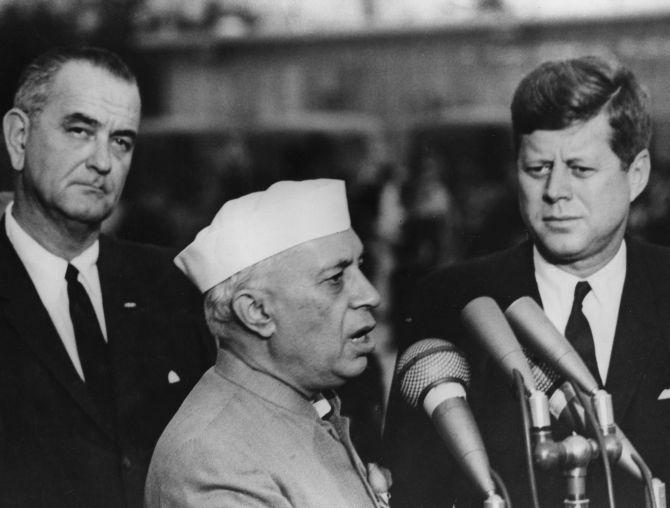
I n 1949, Nehru spent three weeks travelling across the US, addressing several meetings at which he explained India’s foreign policy tenets. It was a public relations success but the official part of his American visit, particularly his meetings with then US President Harry S Truman, were a flop. Truman refused to help with economic or food aid.
It was Nehru’s 1956 visit that heralded the best years of India-US ties. Nehru spent a day and a half at then US President Dwight D Eisenhower’s Gettysburg farm, with the two leaders holding discussions for about 14 hours. Nehru and Eisenhower built a healthy rapport. In the next few years, the Eisenhower administration doubled economic aid to India to $822 million and approved the PL 480 food programme. In 1959, Eisenhower paid a hugely successful visit to India. Nehru’s last visit to the US (1961) proved disappointing, despite then US President John F Kennedy holding him in high esteem. As a senator, Kennedy had been a supporter of more aid to India. The 1961 Nehru-Kennedy summit meetings were tepid. The 71-year-old Indian leader came across as too tired, with Kennedy forced to keep up the conversation. “It was like trying to grab something in your hand, only to have it turn out to be fog,” Kennedy said of his discussions with Nehru. Kennedy rated it his “worst state visit ever”. But the Kennedy administration approved increased aid.
In November 1961, Time magazine reported Nehru’s schedule in the US was so crowded that it “barely left him time to change the perennial red rose on his achkan tunic”.
2) Indira Gandhi
Key visit: November 1971 All trips: March 27-April 1, 1966; November 3-6, 1971; July 27-31, 1982
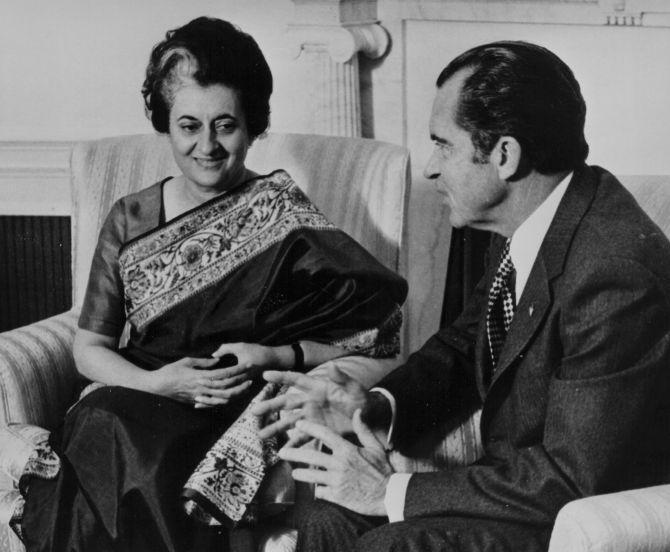
I ndira Gandhi visited the US in 1966, within two months of taking over as India’s PM. Then US President Lyndon B Johnson was much impressed by her. The visit helped India secure more food and development aid from the US. But soon, ties went downhill because of Johnson’s tight-fisted attitude to PL 480, and New Delhi’s refusal to support America on Vietnam.
In 1971, a month before the India-Pakistan war, Gandhi visited the US to convince Washington of the humanitarian crisis in Bangladesh (then East Pakistan), citing the excesses of the Pakistani army. Her equation with then US President Richard Nixon had never been healthy. At that time, Nixon needed Islamabad for rapprochement with China.
Complete Coverage: Modi's US visit
In the process, India was thrown into the arms of Soviet Russia. India-US relations hit rock bottom, with Americans suspecting India of inciting the conflict in East Pakistan. During their statements on the White House lawns, Nixon skipped the subject of atrocities in East Pakistan, receiving a pointed rebuke from Gandhi. Next day, he made her wait 45 minutes for a formal meeting.
Excerpts from the external affairs ministry’s annual report for the year 1971-72 bear out the testy relationship: “Every stratagem of effort and persuasion was tried by India to make the US administration respond with some human feeling to the epochal carnage in East Bengal let loose by the West Pakistan military regime…No government in the world uses the terms ‘peace’ and ‘freedom’ so copiously as the leaders of the US administration do on every conceivable occasion. Yet, these words seemed to have no meaning for them when it related to the people of Bangladesh…It seemed the last trace of the most elementary justice and compassion had dried up in the US administration.”
Gandhi’s 1982 visit, at then US President Ronald Reagan’s invitation, turned out to be markedly successful, with the two leaders agreeing on cooperation in science and technology and signing an agreement on the Tarapur nuclear plant and to mark 1985 as the ‘year of India’ in the US.
3) Morarji Desai Key visit: June 12-15, 1978
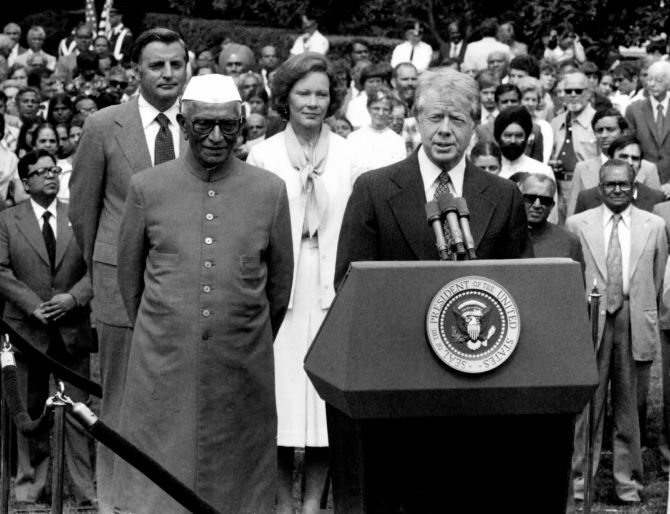
D esai visited the US within months of then US President Jimmy Carter’s visit to India in January that year. Desai’s visit went off well, despite the fact that Americans weren’t keen to ship enriched uranium for the Tarapur nuclear plant.
4) Rajiv Gandhi
Key visit: June 1985 All trips: June 11-15, 1985; October 23, 1985 to attend UNGA; and October 19-20, 1987
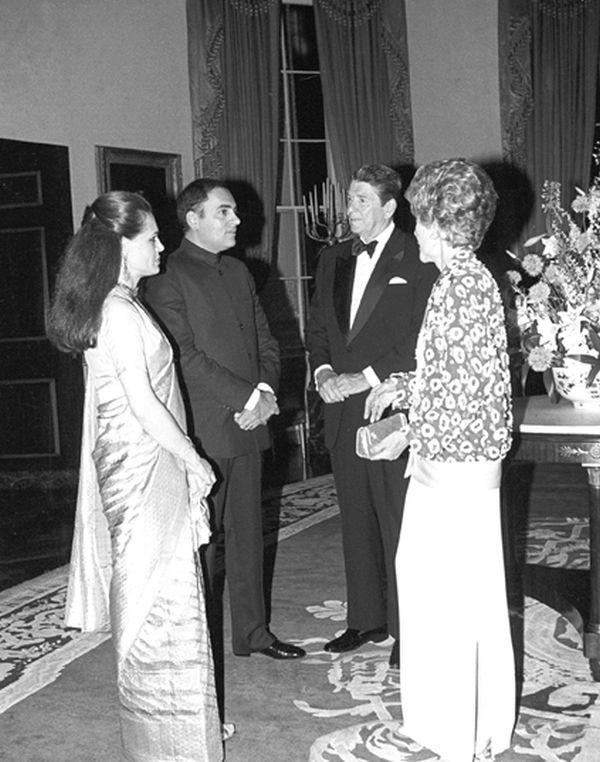
R ajiv charmed Washington during his June 1985 visit. To the Americans, he came across as less preachy than his grandfather, as well as his mother. He spoke softly, listened carefully and spoke with humour. He addressed the Congress, an honour earlier accorded to Nehru, not to Indira. Rajiv also opened the Festival of India and initiated negotiations on purchasing the Cray supercomputer for weather research. Rajiv’s 1987 visit was a tamer affair.
5) PV Narasimha Rao Key visit: May 1994 All trips: January 31, 1992 to attend UNGA; and May 17-20, 1994 R ao visited Washington in 1994, in the backdrop of the economic reforms his government had unleashed, and at a time when India-US ties were at a historical low. The US had repeatedly questioned India’s human rights record in Kashmir and Punjab and its nuclear weapons policy. It had pressured Russia to not sell cryogenic technology to India and disapproved of New Delhi's missile programme. Rao’s visit marked a revival in ties. The Indian PM spoke of the need to “free India-US relations from the distortions induced by the Cold War”. He addressed a joint meeting of Congress, indicated India would go slow on its missile programme and promised further economic reforms. The telecom sector was opened to American companies. The US recognised India as one of the 10 major markets for American trade and investment and became the largest investor in India’s infrastructure sector. Rao’s visit laid the foundations of closer India-US ties during the years of the Atal Bihari Vajpayee and the Manmohan Singh governments.
6) IK Gujral Key visit: September 22, 1997 to attend UNGA.
7) Atal Bihari Vajpayee Key visit: September 2000 All trips: September 13-17, 2000; November 7-9, 2001; September 12 2002 and September 24 2003 to UNGA
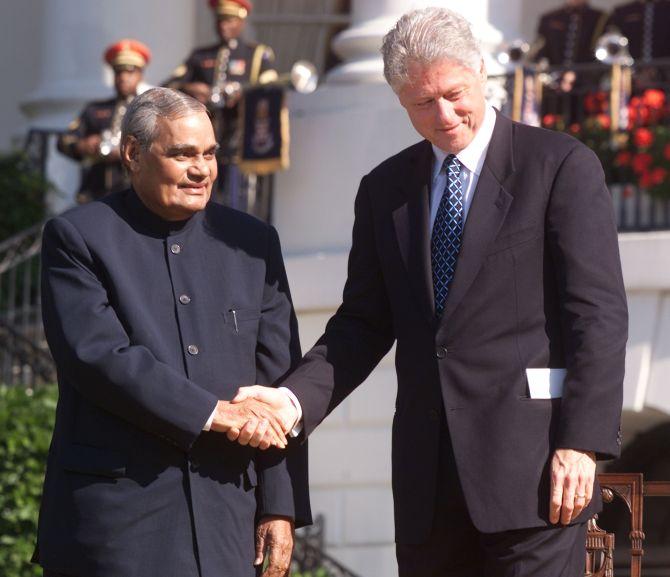
V ajpayee’s September 2000 visit was at a time when then US President Bill Clinton held Pakistan responsible for the violence in Kashmir. Washington also refused to meddle in Kashmir’s affairs at Islamabad’s beckoning. Economic ties were strengthened. Vajpayee termed India and the US “natural allies”. He addressed a joint session of Congress. His 2001 visit, months after the 9/11 terror attacks, paved the way for deeper intelligence sharing between the two countries, with New Delhi providing much strategic assistance pertaining to the Indian Ocean and South Asian regions to the George W Bush administration.
8) Manmohan Singh
Key visit: July 2005 All trips: September 21 2004 to attend UNGA; official visit July 17-20, 2005; working visit September 23-25, 2008; to attend G20 Summits November 2008 and September 2009, official state visit November 23-25, 2009, to attend Nuclear Security Summit April 11-13, 2010; working visit September 27 2013
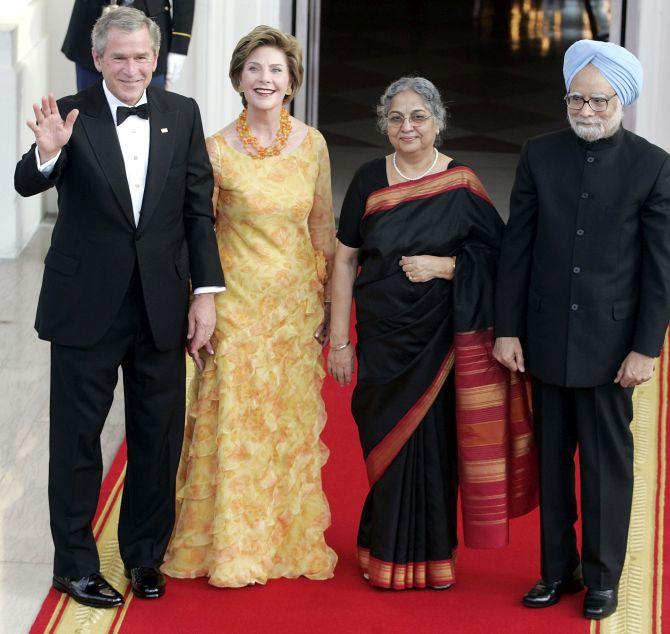
T he joint statement issued after Singh and then US President George W Bush’s meeting on July 18, 2005, is a milestone in India-US relations. It built on the ‘Next Steps in Strategic Partnership’ signed in January 2004. The July 18 statement paved the way for civil nuclear cooperation between the two countries, as well as the deepening of defence ties. It also instituted dialogue on energy. Singh’s 2009 visit to Washington was also significant, as he was the first head of government to be hosted at the White House by the Barack Obama administration. It led to India and the US starting strategic dialogue, which now covers about 30 sectors.

India Votes 2024
More like this, vivekananda, desh ki dharti on modi show in new york, economic issues key to modi's us visit.
News India | Latest News India | Bollywood News | Indian Cricket Score | India Business News

Foreign Relations of the United States, 1961–1963, Volume XIX, South Asia
67. telegram from the department of state to the embassy in pakistan 0.
1122. For Rountree and Galbraith Only. Subject US sale military equipment to India discussed in position paper prepared Nehru visit follows: “US sympathetic towards India’s efforts to strengthen itself against increasing ChiCom military strength and aggressive inclinations. US prepared to consider Indian requests for certain items of dual-purpose military equipment such as transport aircraft, high-altitude helicopters, radar, engineer bridging and construction equipment, and to supply such items if desired on terms as favorable as circumstances permit.”
Dec. 4 letter from Defense 1 states Nehru visit position paper on military equipment sales “appears to provide sufficiently flexible basis for further action,” and that President “while not stating exact text of this [Page 151] position with Nehru did discuss matter of continuing US aid to India in terms which left opening for future discussion on this specific subject.” Citing various AIRA and Embtel New Delhi messages indicating Engineer 2 moving towards showdown with Menon also possible imminent arrival Soviet military sales mission to India, Defense believes positive action required now, that US should take steps convey substance our agreed policy sales military equipment to GOI either through Indian Embassy Washington or Embassy New Delhi.
As you aware President has also given personal commitment Ayub to discuss with GOP prior USG decision provide military aid to GOI . We believe Ayub would probably not object USG supplying GOI with dual-purpose military equipment (he had relatively mild reaction to USG supply C-119s in 1960 although this military sale) but we believe Ayub would object strongly USG supply F-104s or Sidewinders. Supply these two items complicated by classification although understand Defense may be able make unclassified version available Indians.
Dept understands Indians prefer pay rupees rather than dollars for US equipment and would probably consider rupee transactions as not inconsistent with India’s “neutralist” foreign policy. However, such transactions in US administrative procedures are considered MAP and India would undoubtedly be classified publicly along with US allies and others who receive US military assistance.
FY 1963 MAP now in initial stages preparation for Congressional presentation, and therefore time important.
Before taking decision on dual-purpose supply Department desires you discuss entire problem during your Dec 11-13 mtg and forward your recommendations. Particularly desire comments and recommendations on (1) advisability; (2) method of approach; (3) timing; and (4) possible repercussions. 3
- Source: Department of State, Central Files, 791.56/12-861. Secret; Priority; No Distribution Outside Department. Drafted in NEA/NR by Marvin C. Kettelhut and Edward A. Padelford on December 6; cleared by Weil and with G/PM and AID ; and approved by Talbot . Also sent to New Delhi. ↩
- A copy of this letter from William Bundy to Talbot is in the Washington National Records Center, RG 330, OASD/ISA Files: FRC 64 A 2382, India 440-702. ↩
- Air Marshal A.M. Engineer , Air Force Chief of Staff. ↩
- Galbraith and Rountree responded in joint telegram 1038 from Karachi, December 16. The Ambassadors agreed that it was inadvisable to inform the Pakistani Government about the policy concerning the sale of military equipment, as proposed in this telegram. The principal objection was the conviction of the Embassy in Karachi that to do so would cause major damage to U.S. relations with Pakistan. The Ambassadors disagreed on the desirability of indicating to the Indian Government U.S. willingness to receive military aid requests from India. Rountree felt strongly that to accede to such requests would have a similarly adverse effect upon U.S. relations with Pakistan. (Department of State, Central Files, 791.5/12-1661) ↩

IMAGES
VIDEO
COMMENTS
Motion picture covering the official state visit of Prime Minister Jawaharlal Nehru of India to the United States. Prime Minister Nehru and Indira Gandhi arrive at Newport, Rhode Island, and then go to Washington, D.C., with visits to the White House for meetings with President John F. Kennedy, New York City and United Nations (UN) headquarters, and Los Angeles, California.
Please subscribe to the channel and save new links: The same video in English with subtitles: https://youtu.be/0pB9X9romq4 A Dubbed version in Hindi: https:/...
Published: 26 Jun 2023, 8:00 AM. Jawaharlal Nehru's first state visit to the US as the prime minister of India came in October 1949 and lasted almost a month. President Truman sent his own plane to bring Nehru from London. Nehru addressed both houses of the US Congress separately on 13 October.
United States: New York City: 26 September 1960 UN General Assembly Soviet Union: 1961 United States: Newport, Rhode Island New York City Los Angeles: 6-10, 17 November 1961 State visit Mexico: 14-17 November 1961 State visit United Arab Republic: Cairo: 18 November 1961 Meeting with Nasser and Tito Ceylon: 1962 State visit Nigeria
October 28, 2023 10:01:49 AM EDT. This folder contains material collected by the office of President John F. Kennedy's secretary, Evelyn Lincoln, concerning India, and pertains to a visit to the United States by Prime Minister of India Jawaharlal Nehru. Of note is a draft with annotations of a toast by President Kennedy to Nehru.
A Welcome Visitor to the United States, Prime Minister Nehru, Guest of President Kennedy and the American People, November 1961Motion picture covering the of...
The Nehru Visit. Few foreign visitors to the United States have attracted greater public attention than Prime Minister Nehru who paid his fourth visit to that country in November 1961, accompanied by his daughter, Mrs. Indira Gandhi. Retrospective Edition, January 2022.
With India's Prime Minister Narendra Modi set to embark on a transformational state visit to Washington on June 22, it is interesting to keep this equally re...
Nehru, who last visited Washington in 1956, complained only a few years ago that he was "flat and stale." But Nehru who will be 72 next week, has lately radiated energy and good health.
About Us; Vision & Mission; Objectives; Family Tree; Places of Residence. Swaraj Bhawan; Anand Bhawan; Teen Murti House; Important Dates. Early Life; Marriage; Freedom Struggle; ... Home Video Gallery Nehru's Visit to U.S., 1961(Part-I) Nehru's Visit to U.S., 1961(Part-I) Nehru's Visit to U.S., 1961(Part-I) Source: Nehru Memorial Museum ...
In 1961, Nehru again went to the US on an official visit. advertisement Katharine Frank recalls in her book, Indira, that driving past the huge mansions of super rich in Newport, Connecticut, Kennedy jocularly remarked to Nehru that this was how the poor in America lived.
ed on Nehru visit to US notes US annoyance at tendency of Indian delegation to Assembly to equate USSR blasts with US underground explosions. ... 1961, Section E, Page 8 Buy Reprints.
Informal visit. February 20, 1961: Prime Minister Menzies: Australia: Informal visit; discussed Laos crisis with President Kennedy. ... November 3, 1961: Prime Minister Nehru: India: Official visit. In U.S. November 5-14, visiting Newport (Rhode Island), New York City, and Los Angeles. ... United States Department of State. [email protected] ...
However, Nehru did make three important visits to the US in 1949, 1956 and 1961. The video clips below of these visits speak of the warm welcome he received in those times from the successive Presidents of the US, Harry S. Truman, Dwight D.Eisenhower and John F.Kennedy with whom he had three meetings during the one visit. 1949. 1956. 1961.
New Delhi, India. Date of Death: May 27, 1964. Jawaharlal Nehru was born on November 14, 1889, in Allahabad, India. He was leader of India's nationalist movement and India's first prime minister after independence (1947-1964). Nehru was educated at home until age 16 and then continued his education in England at the Harrow School and later ...
PM Nehru's 1961 trip to the US. He was invited for dinner at the White House, spoke at the UN General Assembly, and interacted with the diaspora… This was Prime Minister Nehru in 1961. Share on. Share on WhatsApp; Share on Facebook; Share on Twitter; Copy the URL; Brut. 22 June 2023 5:27 PM.
About Press Copyright Contact us Creators Advertise Developers Terms Privacy Policy & Safety How YouTube works Test new features NFL Sunday Ticket Press Copyright ...
Prime Minister Nehru: Official visit. In U.S. November 5-14, visiting Newport (Rhode Island), New York City, and Los Angeles. ... Stopped in New York City November 17 en route to London. November 6-10, 1961: President Radhakrishnan: State visit. In U.S. June 2-11, visited Williamsburg (Virginia), Philadelphia (Pennsylvania), Cape ...
Experts have noted that apart from starting a new chapter in bilateral relations, Nehru sought to secure commitments of food aid during his visit to the US in 1949, given the Bengal famine had occurred just six years earlier. In this respect, some reports called the visit a "flop". A noted, "Nehru's session with Truman proved to be a ...
Folder Description. This folder contains material collected by the office of President John F. Kennedy's secretary, Evelyn Lincoln, concerning India, and consists of a briefing book for a visit by Prime Minister of India Jawaharlal Nehru to the United States from November 6-9, 1961.
Nehru's last visit to the US (1961) proved disappointing, despite then US President John F Kennedy holding him in high esteem. As a senator, Kennedy had been a supporter of more aid to India ...
Jawaharlal Nehru 's visit to United States of America, 1961. Jawaharlal Nehru 's visit to United States of America, 1961. Panditji was a very astute statesman. He covertly rejected American overture from Eisenhower times. He understood the importance of aligning closely with USSR because he knew that India was not ready for capitalist way of life.
67. Telegram From the Department of State to the Embassy in Pakistan 0. Washington, December 8, 1961, 10:24 p.m. 1122. For Rountree and Galbraith Only. Subject US sale military equipment to India discussed in position paper prepared Nehru visit follows: "US sympathetic towards India's efforts to strengthen itself against increasing ChiCom ...